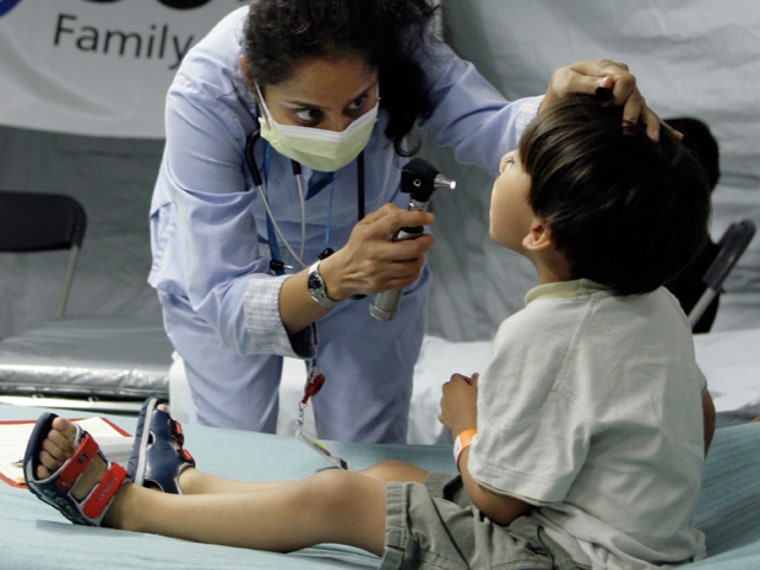Twenty-five states and large cities in the U.S. have placed first orders for the swine flu vaccine, with 600,000 doses of the drug expected to arrive by next week, federal health officials said Thursday.
Washington, D.C., New York City, Chicago and Philadelphia will be among the initial areas where people can get the vaccine to prevent the fast-spreading H1N1 influenza, distributed first in the form of a nasal spray.
It's the first step of a daunting national vaccination program expected to start slowly and gain steam during a rapidly worsening flu season.
"More vaccine is being produced and more vaccine is being ordered and more vaccine is being shipped," said Dr. Anne Schuchat, director for respiratory diseases at the Centers for Disease Control and Prevention. "We need a little bit of patience the first couple of weeks."
States placing early orders include Alaska, Arkansas, Delaware, Georgia, Hawaii, Idaho, Indiana, Kentucky, Maine, Maryland, Mississippi, Nevada, North Carolina, Oklahoma, Oregon, South Dakota, Tennessee, Texas, Utah, Washington and Wisconsin.
The earliest batch of vaccine is expected to protect 6 million to 7 million people. Eventually, 10 million to 20 million doses of vaccine a week, mostly in the form of shots, will be available. The U.S. has ordered a total of 250 million doses, but will send 10 percent of that to other countries.
The nasal spray, which contains a weak version of the live flu virus, can't be used in some people most at risk for illness, including pregnant women and those with underlying medical conditions.
But the spray is recommended for other people between the ages of 2 and 49 in the CDC's priority groups. That would include health care workers, who are being urged to get vaccinations early to protect patients and sustain the public health system.
New data expected Friday likely will show that flu activity is widespread in most parts of the U.S., Schuchat said, adding: "Most states have substantial disease right now."
Scientists have predicted that about 35 percent of the U.S. population could come down with swine flu symptoms, and with about half actually infected with the virus.
Report: 15 states could run out of hospital beds
In a separate report released Thursday, flu analysts predicted that if a third of people wind up catching swine flu, 15 states could run out of hospital beds around the time the outbreak peaks.
The nonprofit Trust for America's Health estimates the number of people hospitalized could range from a high of 168,000 in California to just under 2,500 in Wyoming.
The public health advocacy group used government flu computer models to study how quickly hospitals would fill up during a mild pandemic, like the kind the swine flu — what doctors prefer to call the 2009 H1N1 strain — is shaping up to be. It based its estimates on the mild 1968 pandemic,
Even though only a fraction would be sick enough to be hospitalized, health officials are bracing: When H1N1 first appeared in the spring, more than 44,000 people visited emergency rooms in hard-hit New York City, the report noted. Just sorting out which patients are sick enough to be admitted from the vast majority who need to go home is a big job. And hospital capacity varies widely.
By the outbreak's peak, the new report suggests Delaware and Connecticut hospitals would fill up soonest. Also on that list: Arizona, California, Hawaii, Maryland, Massachusetts, Nevada, New Jersey, New York, Oregon, Rhode Island, Vermont, Virginia and Washington.
To deal with overcrowding from emergencies, hospitals are supposed to have "surge" plans — when they would postpone elective surgeries to free up beds, for instance, and when they might even need to call in government help for mobile hospital units.
100 pregnant women hospitalized; 28 died
So far, most cases of the disease remain mild, causing only typical symptoms of flu, including fever, cough, headache, body aches and exhaustion. But the illness also has caused severe disease in some people, including previously health young adults and pregnant women.
Through late August, Schuchat said, about 100 pregnant women in the U.S. have required hospitalization in intensive care units after being infected with H1N1, and 28 have died, Schuchat said.
"This is a serious virus and vaccine is the best way to protect you and the ones you love," she said.
